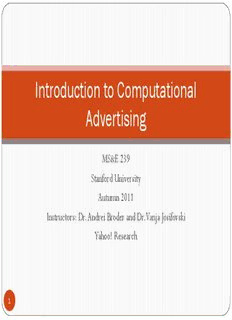
Introduction to Computational Advertising - Stanford University PDF
Preview Introduction to Computational Advertising - Stanford University
Introduction to Computational Advertising MS&E 239 Stanford University Autumn 2011 Instructors: Dr. Andrei Broder and Dr. Vanja Josifovski Yahoo! Research 1 General course info Course Website: http://www.stanford.edu/class/msande239/ Instructors Dr. Andrei Broder, Yahoo! Research, [email protected] Dr. Vanja Josifovski, Yahoo! Research, [email protected] TA: Krishnamurthy Iyer Office hours: Tuesdays 6:00pm-7:30pm, Huang Course email lists Staff:msande239-aut1112-staff All: msande239-aut1112-students Please use the staff list to communicate with the staff Lectures: 10am ~ 12:30pm Fridays in HP Office Hours: After class and by appointment Andrei and Vanja will be on campus for 2 times each to meet and discuss with students. Feel free to come and chat about even issues that go beyond the class. 2 Course Overview (subject to change) 1. 09/30 Overview and Introduction 2. 10/07 Marketplace and Economics 3. 10/14 Textual Advertising 1: Sponsored Search 4. 10/21 Textual Advertising 2: Contextual Advertising 5. 10/28 Display Advertising 1 6. 11/04 Display Advertising 2 7. 11/11 Targeting 8. 11/18 Recommender Systems 9. 12/02 Mobile, Video and other Emerging Formats 10. 12/09 Project Presentations 3 Lecture 06: Display Advertising Part 2 Based on A. David Hallerman, Buying Display Ad Inventory, E-Marketeer Webinar, Aug 25. 201 B. Agarwal, Kota, Agrawal, Khanna: Estimating Rates of Rare Events with Multiple Hierarchies through Scalable Log-linear Models, KDD 2010 C. Slideware from many sources D. Help from many colleagues in particular, Jai Shanmugasundaram Disclaimers This talk presents the opinions of the authors. It does not necessarily reflect the views of Yahoo! inc or any other entity. Algorithms, techniques, features, etc mentioned here might or might not be in use by Yahoo! or any other company. These lectures benefitted from the contributions of many colleagues and co-authors at Yahoo! and elsewhere. Their help is gratefully acknowledged. 5 Lecture plan for today Review of last lecture Non guaranteed display advertising Presentation on Mobile advertising [15 min incl discussion] Prediction technology 6 Guaranteed vs.. Non-Guaranteed Advertiser can buy the ad space 1. in advance (1-24 months) as GD Pay a premium Get premium inventory Many targeting attributes 2. on the spot market (at the time of page view) as NGD 7 Why GD? Currently, GD commands premium prices and is also known as “premium inventory” or “direct buy” Bought directly from publisher, via a sales team rather than automated methods Advertisers get maximum control over timing, position, property, etc E.g. GM knows will launch a new model targeted to single, young, irresponsible males in Nov 2011… Can buy an exclusive (no competing ads) In general: quality of inventory (page views) given to GD contracts > non-guaranteed We have seen how to trade-off quality given to GD vs. revenue 8 Key points of last lecture Display advertising Complex optimization problem – a lot more math than you might suspect Interplay of forecasting, optimization, economics Need to have solutions for: 1. Forecast supply, demand, NGD pricing 2. Admission control 3. Pricing 4. Optimal allocation of impressions to contracts 5. Ad serving 9 GD is considered the most desirable inventory
Description: